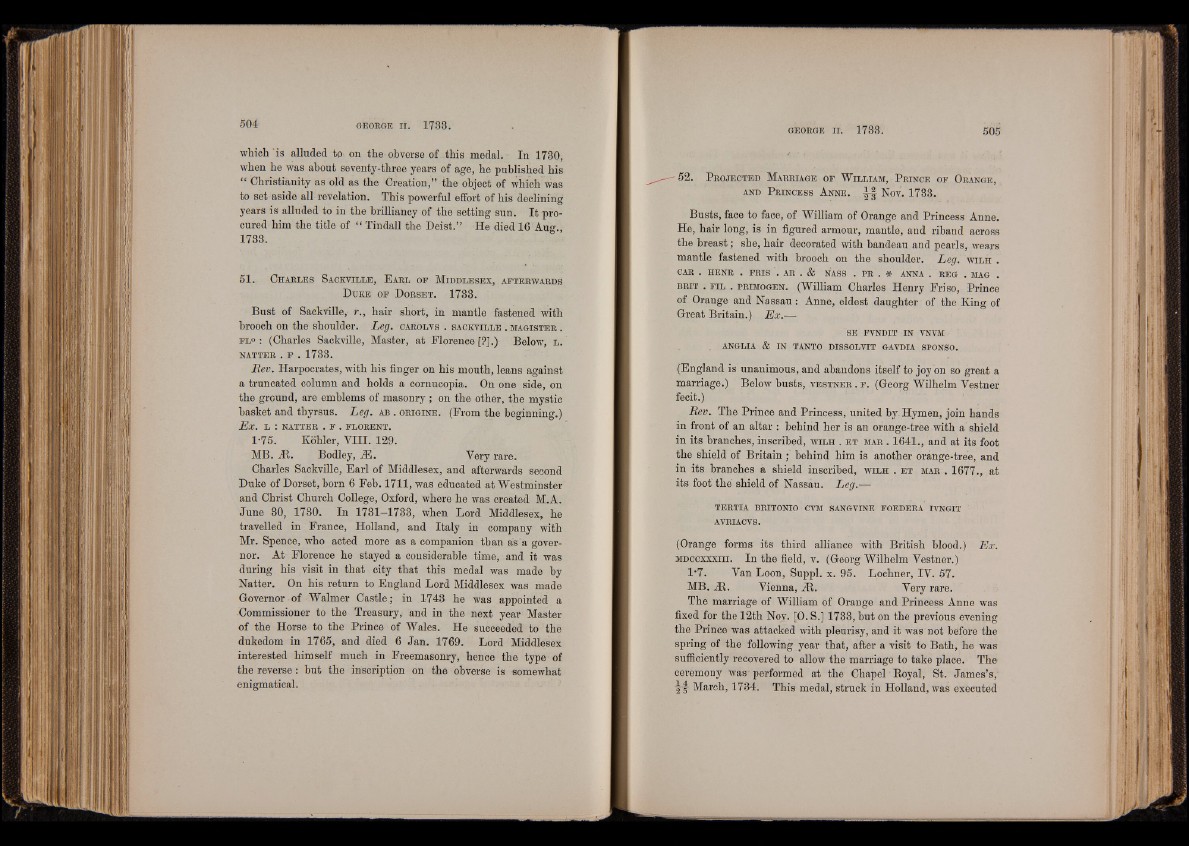
which is alluded to on the obverse of this medal. In 1730,
when he was about seventy-three years of age, he published his
“ Christianity as old as the Creation,” the object of which was
to set aside all revelation. This powerful eifort of his declining
years is alluded to in the brilliancy of the setting sun. It procured
him the title of “ Tindall the Deist.” He died 16 Aus..
1733.
5 1 . C h a r l e s S a c k v il l e , E a r l o f M id d l e s e x , a f t e rw a r d s
D u k e o f D o r s e t . 1733.
Bust of Sackville,' r., hair short, in mantle fastened with
brooch on the shoulder. Leg. c a r o l v s . s a c k v i l l e . M a g i s t e r .
f l ° : (Charles Sackville, Master, at Florence [?].) Below, l .
NATTER . F . 1733.
Rev. Harpocrates, with his finger on his mouth, leans against
a truncated column and holds a cornucopia. On one side, on
the ground, are emblems of masonry ; on the other, the mystic
basket and thyrsus. Leg. a b . o r i g i n e . (From the beginning.)
Ex. L : NATTER . F . FLOEENT.
1-75. Köhler, VIII. 129.
MB. At. Bodley, JE. Very rare.
Charles Sackville, Earl of Middlesex, and afterwards second
Duke of Dorset, born 6 Feb. 1711, was educated at Westminster
and Christ Church College, Oxford, where he was created M.A.
June 30, 1730. In 1731—1733, when Lord Middlesex, he
travelled in France, Holland, and Italy in company with
Mr. Spence, who acted more as a companion than as a governor.
At Florence he stayed a considerable time, and it was
during his visit in that city that this medal was made by
Natter. On his return to England Lord Middlesex was made
Governor of Walmer Castle ; in 1-743 he was appointed a
-Commissioner to the Treasury, and in the next year Master
of the Horse to the Prince of Wales. He succeeded to the
dukedom in 1765, and died 6 Jan. 1769. Lord Middlesex
interested himself much in Freemasonry, hence the type of
the reverse: but the inscription on the obverse is somewhat
enigmatical.
- 52. P r o je c t e d M a r r ia g e o f W il l ia m , P r in c e o f Or a n g e ,
and P r in c e s s A n n e . -|-| Nov. 1733.
Busts, face to face, of William of Orange and Princess Anne.
He, hair long, is in figured armour, mantle, and riband across
the breast; she, hair decorated with bandeau and pearls, wears
mantle fastened with brooch on the shoulder. Leg. w i l h .
CAR . HENR . FRIS . AR . & NASS . PR . * ANNA . REG . MAG .
b r it . f i l . PRiMOGEN. (William Charles Henry Friso, Prince
of Orange and Nassau : Anne, eldest daughter of the King of
Great Britain.) Ex.^> ;
SE FVNDIT IN VNVM
. ANGLIA & IN TANTO DISSOLVIT GAVDIA SPONSO.
(England is unanimous, and abandons itself to joy on so great a
marriage.) Below busts, . v e s t n e r . f . (Georg Wilhelm Vestner
fecit.)
Rev. The Prince and Princess, united by- Hymen, join hands
in front of an altar : behind her is an orange-tree with a shield
in its branches, inscribed, w il h . e t mar . 1641., and at its foot
the shield of Britain ; behind him is another orange-tree, and
in its branches a shield inscribed, w il h . e t mar . 1677., at
its foot the shield of Nassau. Leg.—
TERTIA BRITONIO CVM SANGVINE FOEDERA IVNGIT
AVRIACVS.
(Orange forms its third alliance with British blood.) Ex.
m d c c x x x iii. In the field, v . (Georg Wilhelm Vestner.)
1'7. Van Loon, Suppl. x. 95. Lochner, IV. 57.
MB. At. Vienna, At. Very rare.
The marriage of William of OraDge and Princess Anne was
fixed for the 12th Nov. [Q.S.] 1733, hut on the previous evening
the Prince was attacked with pleurisy, and it was not before the
spring of the following year that, after a visit to Bath, he was
sufficiently recovered to allow the marriage to take place. The
ceremony was- performed at the Chapel Boyal, St. James’s,'
^ March, 1734. This medal, struck in Holland, was executed